In the quiet of a crisp Minneapolis morning in November 2017, Zack Naylor stared at his laptop screen. An email had just blinked into his inbox, in reply to some routine customer research he was doing for his product strategy software, Aurelius. The sender line showed it was from one of their earliest customers, but it was the message itself that sent tingles down his spine.
“We’re actually exclusively using the beta now”.
At that time, Aurelius was product strategy software, just entering its third year. It had recently launched a beta version that reimagined the tool with a focus on research and insights. What made this email special was its confirmation that Aurelius customers were now using the beta—the optional beta—more than the product they were actually paying for.
“It was an interesting, but also a very proud moment… It became very clear to us we should sunset the older product and focus everything on research and insights,” Zack told us.
It was the point where they pivoted direction, changing tack to become the popular research and insights platform we now know as Aurelius.
Planting the Seed: Zack’s Early Career
Zack describes himself in his early career as a “pretty good front-end developer, and an okay visual designer”. He was dabbling with an approach to design that didn’t really have a name or clear definition yet. He was working in start-ups, and through practical experience taught himself the principles of user research. Utterly fascinated, he read everything he could about what would later become popularly known as ‘UX’, working further back in the human-centered design process, starting with his design and development view until he was at the early stages of discovery and product strategy. As many UX professionals can relate, he got bitten by the UX bug and didn’t look back.
Zack had UX experience working in both Fortune 500 and startup contexts, but it was with his move to Minnesota for a job at The Nerdery that many pieces fell into place for him. The Nerdery is a strategy, design and technology consultancy, and his role as the Principal UX Designer there gave him responsibility for up to 50 active projects across his team at any given time. What this meant, practically, was his ten thousand hours in teaching people and building a research practice.
“I realized that while I could teach anybody how to design, it’s much more difficult to teach people the right things to design.”
He also realized that the best way to do this is by creating a design culture with a foundation of customer empathy backed by solid insights gathered from user research.
The Nerdery gave him experience in helping people make the right decisions on designs, products, and features, and as a result, he discovered for himself the constants within this type of effort. “There are a number of patterns for how you ought to approach this work. It doesn’t matter where you are, what the industry is, what your team looks like… There are some pretty basic universal truths”. He wanted to help people make these decisions at scale, rather than have to hire someone every time. It was in this environment and way of thinking that he met his future business partner, Joseph Szczesniak, and Aurelius was born.
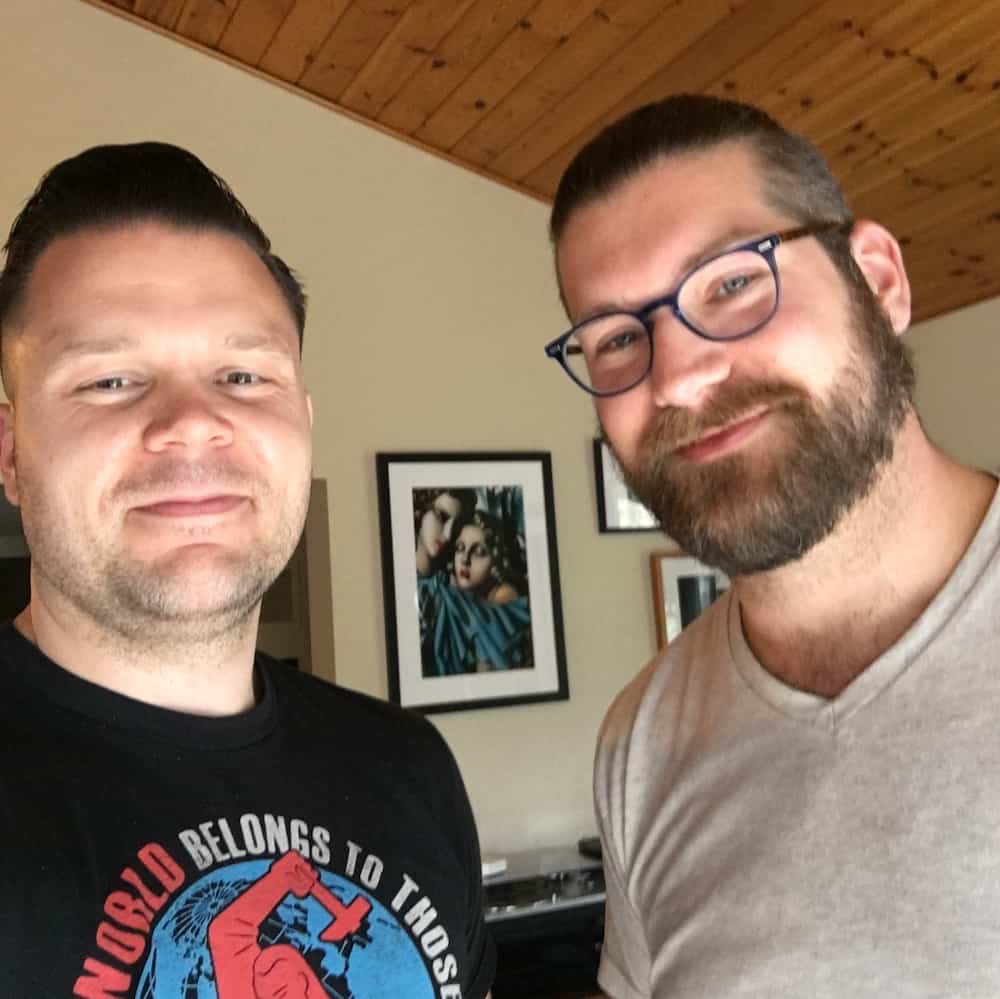
Genesis of Aurelius
It was just before November 2015 that they were in Zack’s basement (surely a place where great ideas are born) discussing product strategy. “There’s got to be a way we can help people make these decisions better—like we did when we were actually hired to help them”. After an inevitable round of brainstorming, they emerged with some exciting concepts for building the software to help.
Aurelius thus began as a product strategy platform that valued research and insights. A lot of hard work went into developing the idea and its execution, and things grew rapidly.
Juggling time while building Aurelius
Aurelius is 100% bootstrapped and self-funded – which means all the design mapping, UI creation, development, startup admin, problem solving, and everything else, happened on their own personal time. Zack would wake up at 4:00am to clock in on Aurelius for several hours, do a morning workout, and then go on to his day job. At night he’d get home to spend more time with his family, then make some more progress on Aurelius.
With two young kids—a one-year-old daughter and a six-year-old son—plus full-time work, commitments as the president of the UXPA, and all of the Aurelius workload, there isn’t much time leftover.
“Any of my time and attention that does not go towards my family, Aurelius, or my full-time job; I basically don’t do”.
Both co-founders are in Minneapolis, but much of Zack and Joseph’s connecting is done remotely. Despite being only 20 minutes away from each other, meeting online is much easier for simply getting things done.
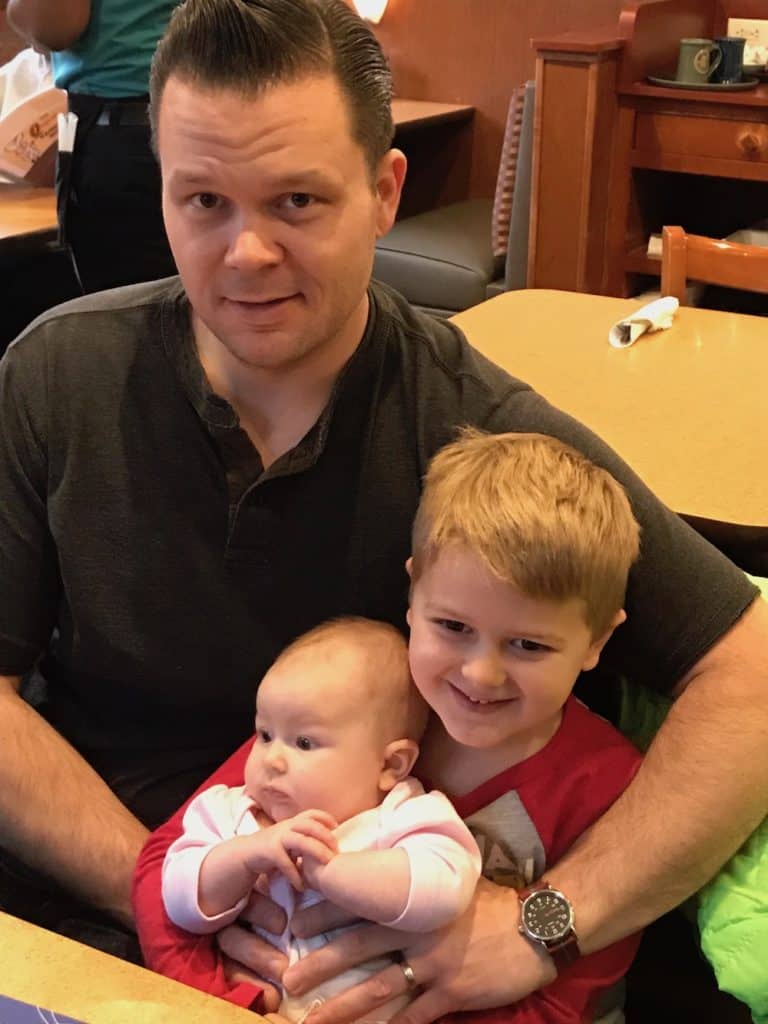
Zack laughed when we asked where he got his energy and persistence from. He says it’s a matter of dedication; it’s because he loves what Aurelius does, and they really want to solve this problem with research, to help people and teams make sense of what they learn.
This motivation is uncommon amongst a startup culture often driven by dreams of corporate takeovers and buyouts. Aurelius intends to remain self-funded. “We don’t want to take funding because both of us have worked in startups and seen how various levels of funding influence direction and priority and, quite frankly, mess up the direction of your product. That’s important to people like us because we are the people who do that work. We want to stay very true to solving that problem.”
As you’d find with many successful startups; it’s also about passion, “We work really hard learning from customers and folks in the industry to help Aurelius support successful products and successful companies. That’s what drives me.”
Motivation to solve the ResearchOps problem
You get another insight about what motivates Zack in the way he describes Aurelius as a vitamin;
“You may not feel like you need to take a vitamin today, but four or five years down the road, if you weren’t getting an essential vitamin, you’d really regret it.”
Aurelius helps you build a research repository so that you can come back and get even more out of the research you’ve already done. “When it comes to ResearchOps, InsightOps, and DataOps, there are great, sophisticated tools for doing the design. But we don’t have good, sophisticated tools for making sure we’re designing the right things. And that’s arguably much more important.”
Zack suggests that most products fall on one side of the fence or the other: they are either a painkiller or a vitamin. Painkillers might suppress the problem for the time being, but vitamins keep the practice healthy for years to come. “Aurelius is very much a vitamin. It helps you grow your research practice into a healthy asset for the business.”
The Pivot: Moving from Product Strategy Tool to ResearchOps Engine
The original version of Aurelius was targetted to product strategy, and Zack estimates ten percent of signups wanted it just as it was. But it was the other 90% that often said things like ‘I love this. I wish we were mature enough to work this way. But tell me more about this research and insights piece that you’ve got’. Once they’d heard that more than a few times, Zack and Joseph got curious. There was a pattern of people struggling with organizing, applying, and getting more out of the research they had already done.
“As you mature in research practice, the broader product strategy problem will actually start to become apparent.”
People were interested in the research and insights potential of Aurelius — but what was the solution? The decision was made to take it out and make it it’s own product: the beta version of Aurelius version 2 was a dedicated research and insights platform. While this was emerging they still had paying customers using the original version 1, but then came the moment that Zack will never forget. “It was one of those early mornings where I got an email from one of our first, early customers on Version 1. I was doing some regular customer research with them… and I remember them saying, ‘We’re actually exclusively using the beta right now’. They had paid upfront for a year’s license of Version 1, but were basically neglecting it for the beta of the new product.”
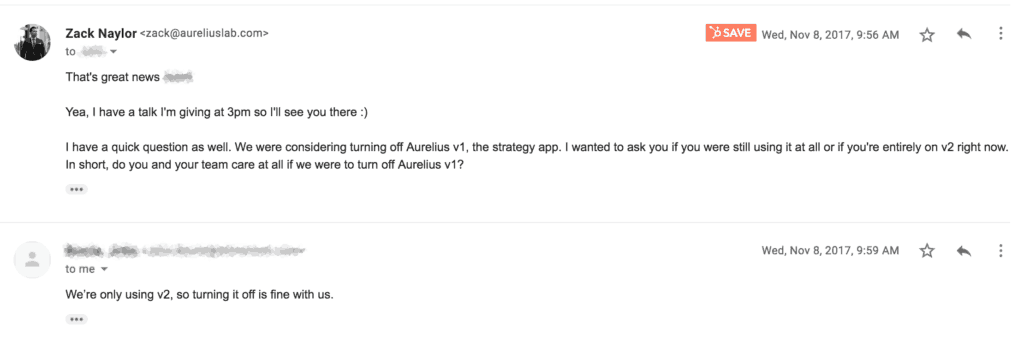
Their customers were using the new beta more than their paid product, justifying it by describing the purpose and supporting functionality as a better fit. It was a very proud moment for Zack. He followed it up with other existing customers “If we killed v1 tomorrow and just continued building this, would you even blink an eye?” The answer? No, they wouldn’t.
“It became very clear to us we should sunset the older product and focus everything on research and insights. And we’ve been far more successful as a result.”
The Shift: How Aurelius Changed
Aurelius reinvented itself as a research and insights platform with some novel approaches to solve traditional problems of user research analysis and synthesis.
In short, it helps you tag, analyze, organize, search, and share everything you learn from a qualitative research dataset. Notes, connections and patterns learned from customers, Aurelius helps speed up the process of discovery.
By collating research in Aurelius, you automatically start building a research library. This holds some powerful potential. When asked what was learnt from a particular research project there are two common outcomes:
- You weren’t the person who did the research, and maybe they’re gone, so a lot of the native fluency with the findings are lost. You may need to redo the research. Or,
- What was learnt wasn’t captured in enough detail by the original report—so it’s only a snapshot in time.
With Aurelius, this isn’t a problem as it’s already been recorded and tagged, possibly even while still in the research session itself. The platform is flexible in how it can work, where you can add and connect key insights. You can take a bottom-up approach where notes can be used to create insights. It was intentionally built flexible enough for customers to do that.
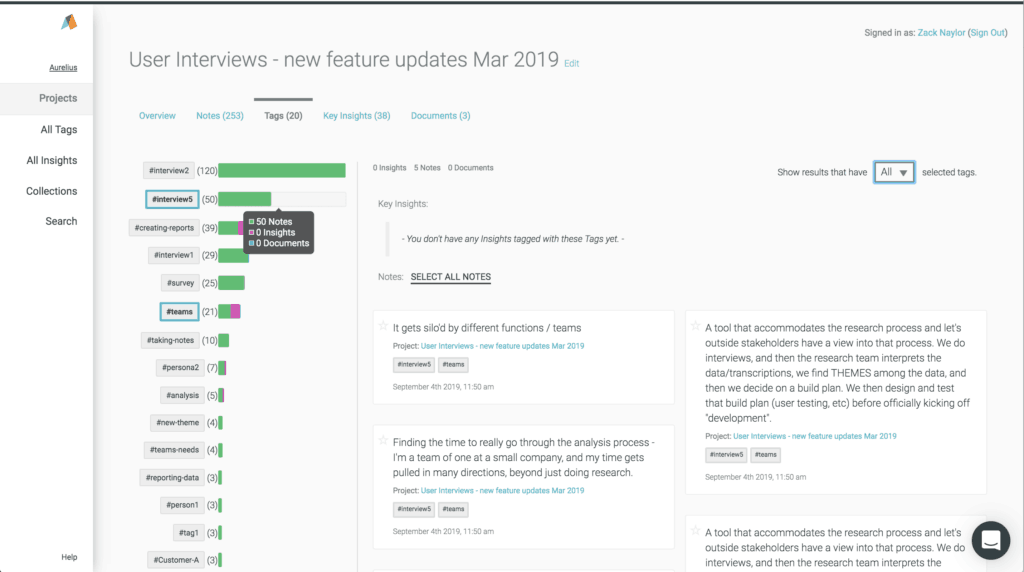
It could also be described as a multi-functional note collation tool. Whether you’re recording research as transcripts, notes—or a mix of both—you can use Aurelius to tag as you record, and then theme and group thoughts you want to focus on and think about more deeply. It helps you see what you have and what you’re still missing, so you have more time to focus and work on your insights.
It also means more flexibility across design teams. You don’t need to just hand over a report; teams can explore and dig deeper into the original data, discovering new things of their own via tags and key insights in the project space. When teams have access to the entire, raw collection of evidence, organized in a way that’s easy to see, new opportunities for discovery can open up.
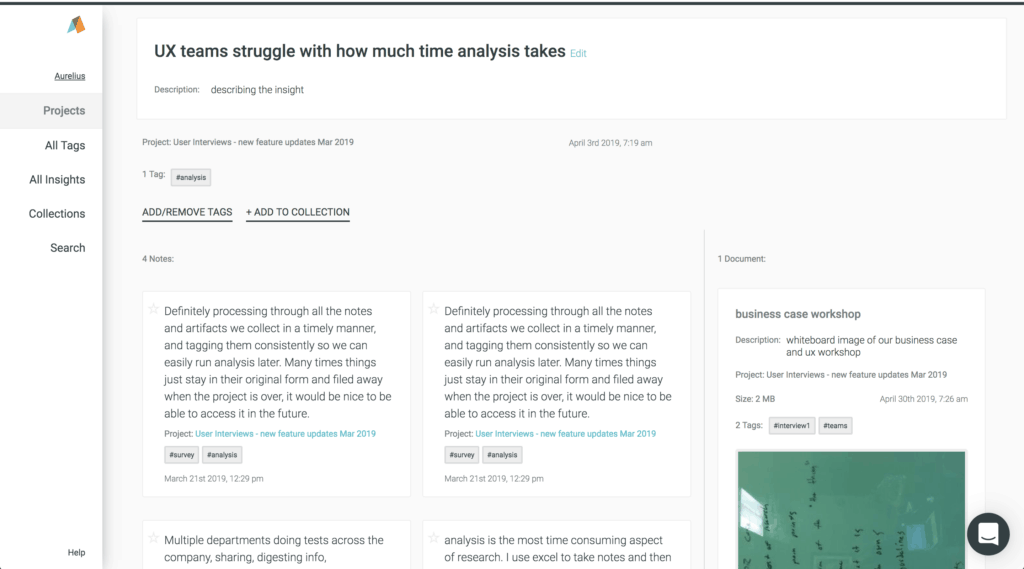
Zack recounts a story shared by a paying customer in the Version 1 days, who told him it was often ‘faster and easier’ for them to do a whole new research project than to put together learnings they had collected in past research.
“I mean, that just hit me like a ton of bricks because that should just never be true… As an industry we can do a better job than that. I got very passionate about tackling it, and today it’s one of the biggest reasons why people come to Aurelius.”
Aurelius supports user experience designers in the way they out to think.
“No single tool will make anybody good at UX design. I very, very strongly believe that. Simply put, Aurelius helps researchers do the work that they are doing today, but makes it faster and easier.”
The Meta of using Aurelius to build Aurelius
Zack and Joseph use their own platform daily, to understand future improvements for the Aurelius platform. “Everything I learned from customers, everything I learn even from prospects of the market, I use Aurelius projects to do that”
“We want research to actually inform the direction of where a company goes because these are the most successful products and companies in my opinion”.
Once teams have the ability to organize and do more things with the research and insights they have stored in a respository, then they’re able to consider the bigger picture, and ask for more of what they need from the platform. Ultimately, as part of Aurelius, Zack wants to support these people as genuinely as possible. And 99% of the time Zack is the one doing that; answering support questions, responding to feature requests, fixing bugs. “I take a lot of pride in the fact that people really appreciate it, despite how small we are. We care about what we’re doing and the people we’re trying to serve”.
Both co-founders are clear about the problem to be solved: to help people make sense of what they learn. “User research is going to help you make better products, better features, better designs, better decisions. We’re just trying to help you do that faster”.
Mention UX Mastery to get 10% off any Aurelius plan, just email Aurelius after you sign up to claim the offer.






very good post.thank you.